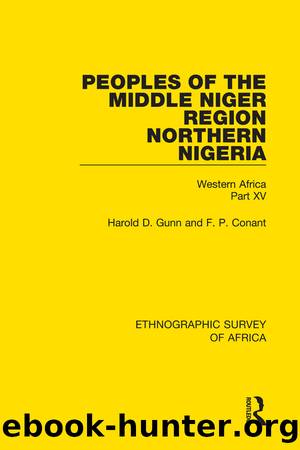Peoples of the Middle Niger Region Northern Nigeria by Harold Gunn F. P. Conant

Author:Harold Gunn, F. P. Conant [Harold Gunn, F. P. Conant]
Language: eng
Format: epub
ISBN: 9781138240834
Barnesnoble:
Publisher: Taylor & Francis
Published: 2019-01-08T00:00:00+00:00
PHYSICAL ENVIRONMENT: ECONOMY: HOUSE-TYPES AND FORMS OF SETTLEMENT: LAND-TENURE
No other people treated in this volume have as varied an environment as do the Basa collectively. Gungawa and Kambari do not have access to uplands such as are found in Abuja, while the peoples of Zuru, like Gbari and Koro to follow, lack any riverain resource to compare with the Benue at Umaisha and at the northern border of Bassa Komo District. In the latter connection, however, it must be noted that Basa do not appear to take the same advantage of the great river at their door as do some sections at least of the Gungawa: Basa Komo are not in fact a true riverain community (see below).
Basa are commonly termed primarily subsistence farmers everywhere; and yet in many districts their efficiency as farmers is specially remarked, and a surplus noted. Miles Clifford designates guineacom, millet, maize and yams as the main crops in Bassa Komo District, common subsidiaries being beniseed, ground nuts, beans, tobacco, pumpkins and âgarden vegetablesâ. Hopkins, however, is of the opinion that maize is rare, grown mainly by foreigners in place of pearl millet, and he comments that tobacco grown locally is poor, and that imported from Koton Karifi preferred. Guineacom is said chiefly to be converted into beer, of which large quantities are consumed. Hopkins (1933) also mentions cotton, cassava and okra: cotton was at one time an important cash-crop, marketed at Lokoja, but the population quickly responded to the low prices of c. 1930, and production dropped sharply (or at least its sale for export was curtailed).8 Hopkins declares yams to be clearly the most important crop, yielding some 11,450 lb. per acre: at that time, about half was exported to the southern provinces (carried mainly by Nupe, Kakanda and Hausa, presumably via the River to Onitsha and Asaba, for Enugu and Benin).
Hopkins describes two types of holdings among Basa Komoâ(conjugal?) family plot (home farm), controlled by âthe head of the familyâ and supplying household needs, and âcollective plotâ (bush farm), the produce of which is controlled by the head of an extended family unit, who acts as treasurer: income from this is used for clothing, taxes, and the expenses entailed by marriages and burials. The two types of plot are roughly the same size: in Oguma Village Area it was estimated in 1933 that on the average âthe individualâs shareâ in the home farm amounted to .74 acre, and in the bush farm, to .66 acre.9
The most important economic trees of the District are the oil palm, locust-bean, sheanut and kâirya (Hausa; Prosopis oblonga).
A wide variety of livestock is mentioned by Temple for the Basa in general: domestic fowls, ducks and pigeons, dogs, swine, goats, sheep and horses, all eaten; whether cattle of any sort may be kept in any part of Basa territory specifically by Basa is uncertain (cf. Oldfield), though Temple refers to the use of cow-horns as musical instruments (in Bassa Komo Dist.?).
Temple indicates that Basa of Nasarawa (presumably including
Download
This site does not store any files on its server. We only index and link to content provided by other sites. Please contact the content providers to delete copyright contents if any and email us, we'll remove relevant links or contents immediately.
| Historic | Information Systems |
| Regional |
Man-made Catastrophes and Risk Information Concealment by Dmitry Chernov & Didier Sornette(5921)
The Revenge of Geography: What the Map Tells Us About Coming Conflicts and the Battle Against Fate by Kaplan Robert D(4034)
Zero Waste Home by Bea Johnson(3777)
COSMOS by Carl Sagan(3553)
Good by S. Walden(3485)
In a Sunburned Country by Bill Bryson(3481)
The Fate of Rome: Climate, Disease, and the End of an Empire (The Princeton History of the Ancient World) by Kyle Harper(3003)
A Wilder Time by William E. Glassley(2818)
Camino Island by John Grisham(2762)
The Ogre by Doug Scott(2631)
Organic Mushroom Farming and Mycoremediation by Tradd Cotter(2626)
Human Dynamics Research in Smart and Connected Communities by Shih-Lung Shaw & Daniel Sui(2465)
Energy Myths and Realities by Vaclav Smil(2437)
The Traveler's Gift by Andy Andrews(2409)
9781803241661-PYTHON FOR ARCGIS PRO by Unknown(2321)
Inside the Middle East by Avi Melamed(2305)
Birds of New Guinea by Pratt Thane K.; Beehler Bruce M.; Anderton John C(2223)
A History of Warfare by John Keegan(2184)
Ultimate Navigation Manual by Lyle Brotherton(2129)
